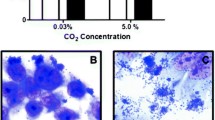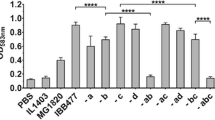Abstract
A quantitative fluorescent in situ hybridization method was employed to evaluate the competitive inhibitory effect of three Lactobacillus strains (Lactobacillus reuteri, Lactobacillus gasseri, and Lactobacillus plantarum) against Escherichia coli internalization in a model system of HT 29 cells. Furthermore, aggregation and adhesion abilities of the Lactobacillus strains were examined. All lactobacilli were able to attach to the HT 29 cells and aggregate with pathogens; however, the adhesion and aggregation degree was strain-dependent. L. reuteri possessed a high capacity of adhesion (6.80 ± 0.63; log CFU ± SEM per well), whereas lower capacities were expressed by L. gasseri (4.52 ± 0.55) and L. plantarum (4.90 ± 0.98). Additionally, L. reuteri showed the rapid or normal ability to aggregate with selected E. coli in comparison with remaining two lactobacilli, which showed only slow or negative aggregative reaction. Internalization of E. coli into the cell lines was markedly suppressed by L. reuteri, while L. gasseri and L. plantarum caused only a minimum anti-invasion effect. The fact that L. reuteri in our experiments showed an outstanding potential for adhering to the colon epithelial cell line, compared with the rest strains, suggested that one of the possible mechanisms of preventing pathogen adhesion and invasion is simple competitions at certain receptors and capability to block receptor binding sites, or that an avid interaction between L. reuteri and the host cell might be modulating intracellular events responsible for the E. coli internalization. Moreover, L. reuteri exhibited a strong ability to aggregate with E. coli, which could be another limiting factor of pathogen invasion.
Similar content being viewed by others
References
Amann RI, Ludwig W, Schleifer KH (1995) Phylogenetic identification and in situ detection of individual microbial cells without cultivation. Microbiol Rev 59:143–169
Bessède E, Angla-gre M, Delagarde Y, Sep Hieng S, Ménard A, Mégraud F (2011) Matrix-assisted laser-desorption/ionization biotyper: experience in the routine of a University hospital. Clin Microbiol Infect 17:533–538
Bujňáková D, Kmeť V (2002) Aggregation of animal lactobacilli with O157 enterohemorrhagic Escherichia coli. J Vet Med B 49:152–154
Bujňáková D, Vlková E, Rada V, Kmeť V (2004) Aggregation of lactobacilli and bifidobacteria with Escherichia coli O157. Folia Microbiol 49:143–146
Cossart P, Sansonetti PJ (2004) Bacterial invasion: the paradigms of enteroinvasive pathogens. Science 304:242–248
Das M, Hart-Van Tassell A, Urvil PT, Lea S, Pettigrew D, Anderson KL, Samet A, Kur J, Matthews S, Nowicki M, Popov V, Goluszko P, Nowicki BJ (2005) Hydrophilic domain II of Escherichia coli Dr fimbriae facilitates cell invasion. Infect Immun 73:6119–6126
Fazeli MR, Shahverdi AR, Sedaghat B, Jamalifar H, Samadi N (2004) Sourdough-isolated Lactobacillus fermentum as a potent anti-mould preservative of a traditional Iranian bread. Eur Food Res Technol 218:554–556
Fazeli MR, Toliyat T, Samadi N, Hajjaran S, Jamalifar H (2006) Viability of Lactobacillus acidophilus in various vaginal tablet formulations. DARU 14:172–178
Fernandez MF, Boris S, Barbes C (2003) Probiotic properties of human lactobacilli strains to be used in the gastrointestinal tract. J Appl Microbiol 94:449–455
Galan JE, Curtiss R (1991) Distribution of the invA, -B, -C, and -D genes of Salmonella typhimurium among other Salmonella serovars: invA mutants of Salmonella typhi are deficient for entry into mammalian cells. Infect Immun 59:2901–2908
Gopal PK, Prasad J, Smart J, Gill HS (2001) In vitro adherence properties of Lactobacillus rhamnosus DR20 and Bifidobacterium lactis DR10 strains and their antagonistic activity against an enterotoxigenic Escherichia coli. Int J Food Microbiol 67:207–216
Harmsen HJ, Elfferich P, Schut F, Welling GW (1999) A 16S rRNA-targeted probe for detection of lactobacilli and enterococci in faecal samples by fluorescent in situ hybridization. Microb Ecol Health Dis 11:3–12
Hirano J, Yoshida T, Sugiama T, Koide N, Mori I, Yokoch T (2003) The effect of Lactobacillus ramnosus on enterohemorrhagic Escherichia coli infection of human intestinal cells in vitro. Microbiol Immunol 47:405–409
Horošová K, Bujňáková D, Kmeť V (2006) Effect of lactobacilli on E. coli adhesion to caco-2 cells in vitro. Folia Microbiol 51:281–282
Huet C, Sahuquillo-Merino E, Courdrier E, Louvard D (1987) Absorptive and mucus-screening subclones isolated from a multipotent intestinal cell line (HT-29) provide new models for cell polarity and terminal differentiation. J Cell Biol 105:345–357
Juven BJ, Schved F, Linder P (1992) Antagonistic compounds produced by a chicken intestinal strain of Lactobacillus acidophilus. J Food Prot 55:157–161
Kmeť V, Lucchini F (1999) Aggregation of sow Lactobacilli with diarrheagenic Escherichia coli. J Vet Med B 46:683–687
Mego M, Májek J, Končeková R, Ebringer L, Čierniková S, Rauko P, Kováč M, Trupl J, Slezák P, Zajac V (2005) Intramucosal bacteria in colon cancer and their elimination by probiotic strain Enterococcus faecium M-74 with organic selenium. Folia Microbiol 50:443–447
Olmsted SB, Dunny GM, Erlandsen SL, Wells CL (1994) A plasmid-encoded surface protein on Enterococcus faecalis augments its internalization by cultured intestinal epithelial cells. J Infect Dis 170:1549–1556
Pyoung IK, Min YJ, Young-Hyo Ch, Saehun K, Seong-Jae K, Yong-Ha P (2007) Probiotic properties of Lactobacillus and Bifidobacterium strains isolated from porcine gastrointestinal tract. Appl Microbiol Biotechnol 74:1103–1111
Qadri F, Svennerholm AM, Faruque AS, Sack RB (2005) Enterotoxigenic Escherichia coli in developing countries: epidemiology, microbiology, clinical features, treatment, and prevention. Clin Microbiol Rev 18:465–483
Qin H, Zhang Z, Hang X, Jiang Y (2009) L. plantarum prevents enteroinvasive Escherichia coli-induced tight junction proteins changes in intestinal epithelial cells. BMC Microbiol 9:63–65
Reid G, Cook RL, Bruce AWV (1987) Examination of strains of lactobacilli for properties that may influence bacterial interference in the urinary tract. I Urol 138:330–335
Reid G, Bruce AW, McGroarty JA, Cheng KJ, Costerton JW (1990) Is there a role for lactobacilli in prevention of urogenital and intestinal infection. Glin Microbiol Rev 3:335–344
Sghir A, Gramet G, Suau A, Rochet V, Pochart P, Dore J (2000) Quantification of bacterial groups within human fecal flora by oligonucleotide probe hybridization. Appl Environ Microbiol 66:2263–2266
Todoriki K, Mukai T, Sato S, Toba T (2001) Inhibition of adhesion of food-borne pathogens to Caco-2 cells by Lactobacillus strains. J Appl Microbiol 91:154–159
Walencka E, Różalska S, Sadowska B, Różalska B (2008) The influence of Lactobacillus acidophilus-derived surfactants on staphylococcal adhesion and biofilm formation. Folia Microbiol 53:861–866
Wells CL, Jechorek RP, Erlandsen SL (1990) Evidence for the translocation of Enterococcus faecalis across the mouse intestinal tract. J Infect Dis 162:82–90
Wells CL, van de Westerlo EMA, Jechorek RP, Erlandsen SL (1998) Cytochalasin-induced actin disruption of polarized enterocytes can augment internalization of bacteria. Infect Immun 66:2410–2419
Acknowledgments
The present work was financially supported by the VEGA project no. 2/0005/11 and the ERDF project no. 26220220152.
Author information
Authors and Affiliations
Corresponding author
Rights and permissions
About this article
Cite this article
Bujňáková, D., Kmeť, V. Inhibitory potential of lactobacilli against Escherichia coli internalization by HT 29 cells. Folia Microbiol 57, 269–272 (2012). https://doi.org/10.1007/s12223-012-0122-9
Received:
Accepted:
Published:
Issue Date:
DOI: https://doi.org/10.1007/s12223-012-0122-9




